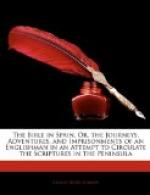which, if they resemble anything, present the appearance
of the fore fins of a seal, and consist of multitudinous
fibres. The fruit, which somewhat resembles
a pear, has a rough tegument covered with minute prickles,
which instantly enter the hand which touches them,
however slightly, and are very difficult to extract.
I never remember to have seen vegetation in ranker
luxuriance than that which these fig-trees exhibited,
nor upon the whole a more singular spot. “Follow
me,” said the Mahasni, “and I will show
you something which you will like to see.”
So he turned to the left, leading the way by a narrow
path up the steep bank, till we reached the summit
of a hillock, separated by a deep ditch from the wall
of Tangier. The ground was thickly covered with
the trees already described, which spread their strange
arms along the surface, and whose thick leaves crushed
beneath our feet as we walked along. Amongst
them I observed a large number of stone slabs lying
horizontally; they were rudely scrawled over with odd
characters, which I stooped down to inspect.
“Are you Talib enough to read those signs?”
exclaimed the old Moor. “They are letters
of the accursed Jews; this is their mearrah, as they
call it, and here they inter their dead. Fools,
they trust in Muza, when they might believe in Mohammed,
and therefore their dead shall burn everlastingly
in Jehinnim. See, my sultan, how fat is the soil
of this mearrah of the Jews; see what kermous grow
here. When I was a boy I often came to the mearrah
of the Jews to eat kermous in the season of their
ripeness. The Moslem boys of Tangier love the
kermous of the mearrah of the Jews; but the Jews will
not gather them. They say that the waters of
the springs which nourish the roots of these trees,
pass among the bodies of their dead, and for that
reason it is an abomination to taste of these fruits.
Be this true, or be it not, one thing is certain,
in whatever manner nourished, good are the kermous
which grow in the mearrah of the Jews.”
We returned to the lane by the same path by which
we had come: as we were descending it he said,
“Know, my sultan, that the name of the place
where we now are, and which you say you like much,
is Dar Sinah (the house of the trades). You
will ask me why it bears that name, as you see neither
house nor man, neither Moslem, Nazarene, nor Jew,
only our two selves; I will tell you, my sultan, for
who can tell you better than myself? Learn,
I pray you, that Tangier was not always what it is
now, nor did it occupy always the place which it does
now. It stood yonder (pointing to the east) on
those hills above the shore, and ruins of houses are
still to be seen there, and the spot is called Old
Tangier. So in the old time, as I have heard
say, this Dar Sinah was a street, whether without or
within the wall matters not, and there resided men
of all trades; smiths of gold and silver, and iron,
and tin, and artificers of all kinds: you had




